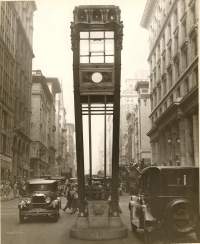New York City Intersections
This page is under construction.
Timeline
The 1920s
Throughout New York City, various intersections (those that were typically major) were controlled mainly by either police officers or traffic control towers. With regards to traffic control towers, these were generally operated by police officers and red and green and red, amber, and green sets were in use. One kind of traffic control tower that is well known to date is the bronze tower, in which was designed by Joseph H. Freedlander and first unveiled by the 5th Av. Association in 1922. Approximately seven were installed on one segment of the major thoroughfare, and these were in use throughout the 1920s. The decorative design of the tower stood out the most, since Freedlander strongly believed in aesthetics. At the top, a police officer was stationed within the inside, and a set of red, amber, and green signal indications were in use.
While the bronze towers were able to provide adequate traffic control, there were some disadvantages. One to point out is the placement of the tower. The ideal spot at an intersection for this tower was the middle, and this eventually proved to be an obstacle for motorists that wanted to make left and right turns at intersections. Another disadvantage to take into consideration is the use of the amber indication. Though it indicates to motorists to slow down and come to a full stop, many motorists were rather confused by the indication and either tried to speed up to clear the intersection or stopped too early, in which either situation sometimes resulted in a bad accident. A solution to alleviate these common issues was necessary.
By the mid 1920s, New York City's police department introduced the first automatically-controlled traffic signals. These first appeared in the boroughs of Brooklyn and Manhattan, and they would soon spread to the rest of the other boroughs in the following decade. The new traffic signals showed red and green signal indications to motorists, in which became a permanent standard for New York City traffic signals, and the amber signal indication was abandoned until its revitalization in the 1950s. The police department's new system of traffic signals were synchronized, in which were intended for an ideal flow of traffic, and various precincts throughout the city had control centers for police officers to manually adjust signal timing (if necessary). At the time, were typically attached to unusually tall pedestals, and solely one was in use at a major intersection. Consider two from Park Avenue in Manhattan as examples. Late 1920s.
